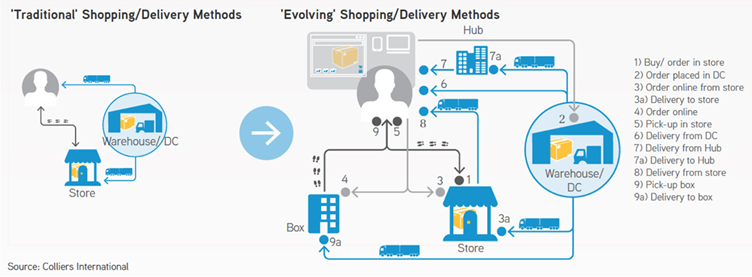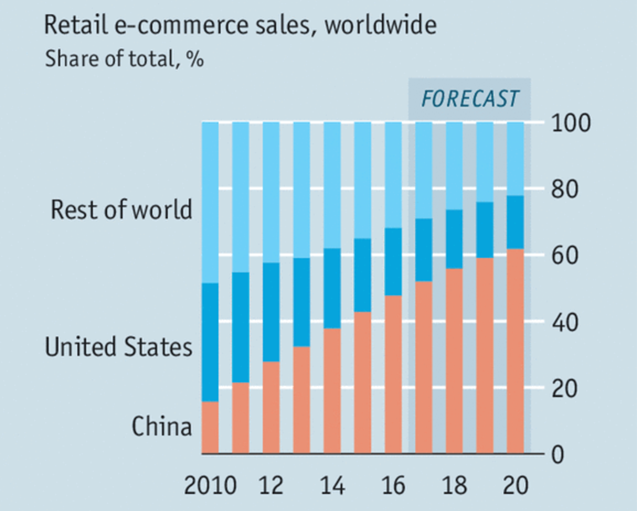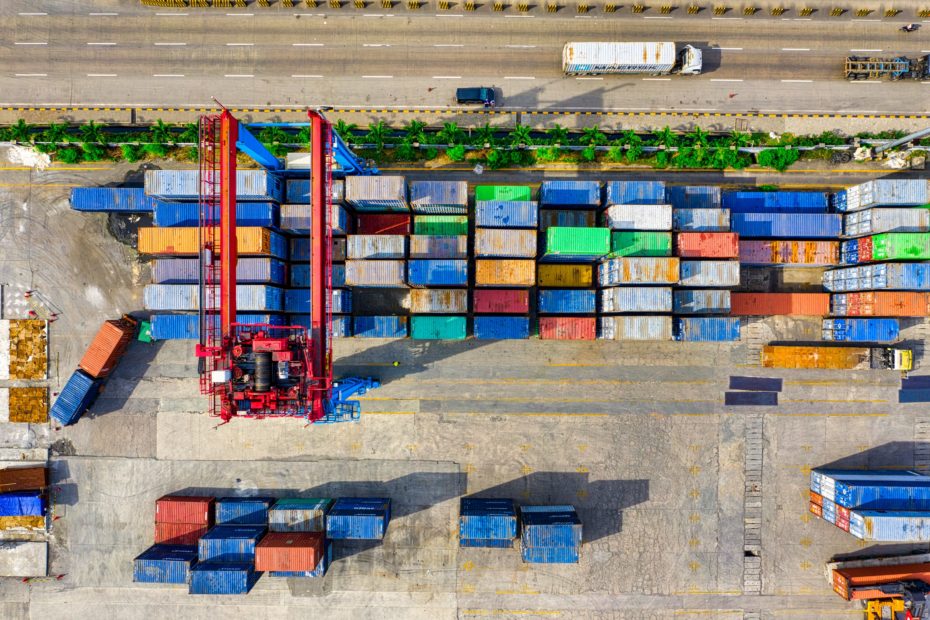The Internet and related technology keep transforming our lifestyle, and constantly evolving digital devices undoubtedly accelerate these changes. As one of the most important and common aspects of people’s daily life, shopping has been drastically altered by the digital world as well. Given the difficulty of examining the overall impact of the Internet and related Information and Communications Technology (ICT) on cities and villages, in his 2020 master’s thesis at Tufts Urban & Environmental Policy & Planning, Xianzheng Fang (M.S. ’20) looked at the impact of e-commerce on urban and rural areas through qualitative approaches and empirical evidence.
Although the importance of e-commerce has increased substantially worldwide over the past decade, 9 of top 10 global e-commerce retailers are from United States and China. Therefore, Fang used Amazon and Alibaba, respectively the largest online shopping companies in the United States and China, to explore how this fast-growing digital service functions in the two largest economies in the world, the corresponding outcomes on the market, and most importantly, its impacts on cities and villages.
Fang’s study shows that e-commerce has extensive influences on traditional retailing, logistics, economy, environment, and urban planning, changing the landscapes of cities and villages. In addition, Fang provided some feasible recommendations from the perspective of planners and policymakers at the end, which may enable urban and rural residents to embrace a more sustainable future in this information age. Read on below for more details of the study.
What has been impacted by the advent of e-commerce?
Today, e-commerce has become a popular and increasingly mainstream consumption option beside traditional “brick-and-mortar” retail, drastically altering people’s daily life and where they live. After exploring dozens of articles and publications, I found such impacts can be summarized into following five categories:
1. Traditional Retailing: Online shopping is more competitive in terms of price due to the relatively lower cost structure. It has changed the means of sharing information about products and distribution channels, reduced travel costs for customers, and eliminated the need for physical proximity, making the comparison of goods and shopping process much more transparent and effortless for buyers. Traditional brick-and-mortar retailers have had to face the fact that they are the declining part of the retail industry. Many public retailers have lost significant enterprise value and are closing their stores at a record pace, and some have even filed for bankruptcy.
2. Logistics and Transportation: Compared to the prevailing massification within the chain retail, e-commerce emphasizes fragmentation and customization. Therefore, mainstream combined transports from centralized warehouses of the past have been replaced by the order-level deliveries sent directly to consumers. Logistically, online retailers tend to build huge fulfillment centers on the outskirts of major cities, but tend to put smaller warehouses as sorting centers inside cities to shorten cycle times of deliveries and to serve as pickup locations for customers.

As for transportation, the demand for delivery—which used to be concentrated but now is spreading throughout cities at all times of day—is massive and growing. It will unavoidably bring some traffic problems, such as traffic congestion, the lack of available parking for delivery trucks, and even some fatal accidents.
3. Economy: E-commerce is creating a sea-change in related employment. That is to say, the digital marketplace is hiring, while certain traditional retailers are losing jobs. The increasing demand for warehouses and fulfillment centers also benefits the industrial real estate market. In some developing countries like China, e-commerce plays a much more crucial role in the economy. In their view, the development of this form of business can increase farmers’ income, alleviate rural poverty, and further change the quality and pace of life of local people, leading to more job opportunities for rural migrants and economic entities in cities and villages.
4. Sustainability: At first, e-commerce was regarded as an environmentally friendly way to consume, which could replace individual trips and reduce traffic pressure and carbon footprints. However, the industry has undergone exponential growth since the early days, and has started to develop in a diametrically opposite direction. The environmental costs of the convenience brought by e-commerce is staggering. In the United States alone, about 165 billion packages are shipped each year, which consumes a quantity of cardboard roughly equivalent to more than 1 billion trees (Peters 2018). This figure doesn’t even include the waste from the single-use plastic products and other additional materials that keep items safe in transit. Moreover, many packages contain harmful substances that are difficult to recycle or degrade and are over-packaged as a result of retailers’ demand that their goods arrive in perfect condition.
5. Urban Planning: As a relatively reactive field and profession, urban planning may have trouble monitoring and following the changing technological development of e-commerce and addressing its consequences on urban form in a timely manner. For example, part of the transportation problems mentioned above is because there are not enough curbside spaces and loading zones for delivery trucks, which was impossible to foresee when the street system was designed and built decades earlier.
More specifically, what are the current impacts of e-commerce on America and China?
The importance of e-commerce has increased substantially over the past decade, especially in two countries—America and China. Consequently, I chose Amazon and Alibaba as my case examples to examine and compare the current effects of e-commerce on these respective countries.

Amazon
As the world’s largest Internet retailer in revenue and market capitalization, the Seattle-based company’s influence went well beyond shopping long ago.
Traditional brick-and-mortar businesses are said to be feeling the brunt of the so-called “Amazon effect.” Seamless shopping processes brought by e-commerce led more and more buyers to browse screens and reward e-tailers with open wallets, instead of going to street-based stores. This can be reflected in the current torrent of store closures in the United States: in 2017, more than 9,400 stores announced that they were closing—the number surpassed the number of shutdowns during the Great Recession (Corkery 2017; Seth 2018). Beside brick-and-mortar businesses, Amazon is also eliminating corresponding retail jobs.
In terms of logistics, in addition to cooperation with third-party couriers, Amazon, the largest digital emporium, is poised to deploy its own delivery service and extend its warehouse network. Concomitantly, the company is expanding its logistics nexus. Its warehouses and fulfillment centers are all over the nation. Not surprisingly, Amazon’s aggressive logistics strategies may lead to more traffic flow in total and make the streets more congested.
The impact of the e-commerce baron on traditional retail and logistics will have repercussions on the economy. The spate of store closures has begun to greatly disrupt the labor market related to the retail industry. By contrast, for small- and medium-sized businesses that display their merchandise on the online shopping platform, Amazon is an influential facilitator, bringing overwhelming job creation and income. Likewise, for trucking, fulfillment centers and related employment opportunities, the growth of e-commerce led by Amazon brings nothing but boons.
At the micro level, Amazon’s economic footprint in cities and regions is more comprehensive and far-reaching. For example, in Seattle, Amazon’s hometown, the influence of the online retail tycoon is omnipresent. On the plus side, Amazon creates massive job opportunities, generates increased tax revenues, and makes huge investments that the city can use to pay for necessary construction that benefit the public and local businesses, like urban infrastructure upgrades. However, the influx of new residents greatly increased the local demand for housing. Due to the relatively high income of Amazon employees, housing prices and rents subsequently skyrocketed, and concurrently, the city had one of the fastest-growing income gaps in the country (Kosoff 2018).
Similarly, it is reasonable to deduce that a firm with the magnitude of Amazon exerts great pressure on the environment. The most evident environmental impacts are associated with freight traffic footprints and waste from over-packaging. What’s more, many packages used by the company contain harmful substances like Thermocol and materials that are difficult to recycle such as bubble mailers.
As for urban planning, cities have been proactively altering their planning processes and requirements in preparation for the company’s arrival, in anticipation of its possible arrival, or to accommodate its distribution centers. Thus, Amazon is producing an “advance effect” on urban planning, often at the expense of existing zoning or prior, consensus-built plans. Considering the numerous employees and huge investments the e-commerce megalith could bring to localities, it is easy to anticipate that many local authorities would be pro-business and possibly neglect the preferences of local residents.
Alibaba
Unlike its western counterpart, Alibaba is more like a middleman, operating an open marketplace to facilitate the sales of commodities without holding or selling any merchandise itself. It connects sellers and consumers and doesn’t charge extra fees on transactions. This fee-free market model brought many benefits to China’s urban and rural areas.
The differences also extend to logistics. Alibaba adopted an asset-light strategy in the spirit of partnership. The company does not own or build any facilities for fulfillment and delivery, from delivery trucks to warehouses to distribution centers. Instead, it chooses to cooperate and coordinate with professional couriers and even brick-and-mortar retailers.
In Alibaba’s home base, Hangzhou, the Chinese e-commerce magnate provides staff, money, or space to local tech startups to repay this city where it has been based for 20 years. On the other hand, the city pinned great hopes on Alibaba’s halo effect, and gave some preferential policies, such as tax exemption or subsidies for startups, and created an enterprising atmosphere throughout the city. Nowadays, besides its scenic beauty and profound historical heritage, Hangzhou is also known as one of Asia’s Silicon Valleys and global technology capitals.
Additionally, Alibaba has also taken up rural areas with aims at redefining this budding market. From the sellers’ perspective, switching from traditional business to the digital marketplace allows them to reach more consumers, including the affluent in megacities who use online platforms. Many vendors in villages started to focus on producing high value items or turning their commodities into specialized products to earn higher profits than local bulk wholesale. For consumers, e-commerce is enabling more and more rural residents to become business owners, and the resulting income growth allows them to buy products that are not available in the local markets, resulting in an economic virtuous circle.
Are there policy directions that planners and policy makers should take?
It is fair to say that e-commerce introduced a new way of shopping and a new kind of urban life. However, municipal officials and developers are unprepared to take e-commerce into consideration when developing urban and rural plans and regulations. Therefore, I put forward some feasible recommendations from the perspective of urban planners and policymakers, which may allow cities and villages to more actively accommodate this information age:
1. City logistics needs to be afforded greater importance in the planning process and political agenda, and related city structures need to be retrofitted.
2. Changing regulations or zoning at the macro level also can be a tool to encourage or reinforce the development of e-commerce. For example, in London, logistics terminals on the River Thames are safeguarded and the land is held for future residential development (Sommar and Mellander 2018).
3. Freight distribution is another missing segment in the current planning framework. Outdated transportation plan, improper traffic rules, and insufficient infrastructure all contribute to today’s nightmarish traffic, which requires more inventive and holistic partnerships between city governments and private companies to formulate scientific and data-driven resolutions.
4. Abundant land freed up by more and more vacant storefronts also denotes other possibilities for municipal authorities. Instead of being tempted by the short-term economic and employment stimulus attached to industrial barons like Amazon, officials should look at far-reaching objectives and invest in a more traditional and socially beneficial field like transportation and public education.
5. In terms of land and property planning, planners must ensure that housing development, especially in cities with e-commerce headquarters, keeps pace with economic development, while actively fostering affordability to protect existing residents from displacement pressure.
6. As for the environmental cost, public sector actors need to ensure that appropriate facilities like recycling infrastructure are poised to allow environmentally conscious companies and consumers to tackle the waste problem, establish relevant standardization, green certification system, even legislation to clamp down on wasteful behavior, and spur all market players to participate in the circular economy.
7. In addition, because e-commerce companies are basically algorithm-driven, city governments can seek collaboration with tech giants, as Hangzhou and Alibaba did, to build a big-data platform to make delivery more efficient and expand its application to other services.
8. Community engagement is a crucial component of their success. Planners need to not only know how goods move, but how people consume to assemble effective strategies and plans. And the best way to do this is to directly involve neighborhoods in finding solutions.
9. Last but not least, buying, per se, is the origin of all related issues. Ergo, informing and educating people about the impacts of e-commerce are extremely important as well, which may check behavior like impulse-buying and make consumers more willing to pay for sustainable products.
Having said that, the problems that the rise of e-commerce presents are undeniably complex. There is no doubt that a great endeavor from all stakeholders, more in-depth research, and innovative thinking are required to identify workable answers for the future.
Cover image from Pexels
